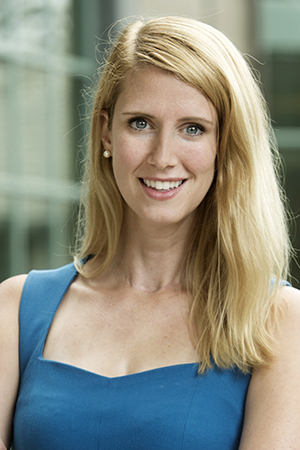Brain scans help researchers untangle the truth about lie detection

It’s that time of year when inboxes and mailboxes are flooded with pleas from a parade of worthy causes—from fighting hunger overseas to aiding victims of the latest natural disaster to funding your local library. Faced with so many needs, do you spread your donation dollars around, or focus on one cause to maximize your impact?
If you’re like most people faced multiple requests for help, you’re likely to divide your donations among requesters because it feels more fair, according to a new Berkeley Haas study. The upshot? You may end up giving less to each requester, but more overall, the study found.

Juliana Schroeder
The paper, co-authored by Berkeley Haas Asst. Prof. Juliana Schroeder and PhD student Daron Sharps and forthcoming in the Journal of Personality and Social Psychology, offers new insights into how people give help. The results could help groups seeking the best strategy to maximize donations.
“People seem to be primarily driven by fairness concerns when allocating help, and when people see more individual requesters, they give more,” said Schroeder, a psychologist in the Haas Management of Organizations Group who studies social interactions and previously looked at how donors give different kinds of help to people they view as less competent. “That was surprising to both of us, since it seems to contrast with the ‘identifiable victim effect.’”
Identifiable victims
That effect is the tendency people have to offer more help to a single, identifiable person with a compelling need than to a large, vaguely defined group such as “earthquake victims”—a phenomenon leveraged by every charity sharing heart-tugging stories and photos. It’s also been found that people don’t tend to give more to larger groups, even though the need is greater: one study by Nobel Prize-winning psychologist Daniel Kahneman found that people will give the same amount to a group of 2,000 as to 200,000.

Daron Sharps
Yet prior studies did not look at whether people were considering each request separately—a psychological phenomenon known as “unpacking”.
“We know that you might get more donations for ‘Tommy’ who was affected by the earthquake than for a million people who were affected by the earthquake, but what about ‘Tommy’ compared with ‘Tommy, Ana, and John’?,” said Sharps, who served as lead author on the study. “We found the important part is the identifiable nature of the recipient, not that it’s one versus many requesters.”
A clear pattern
The researchers studied giving behavior across nine experiments involving 3,100 people, most of whom were recruited through an online platform. They found a clear pattern: When given a choice of how to allocate donations, almost 80 percent of people chose to distribute funds across multiple recipients, with the majority giving some to every requester—and half of those distributing funds equally (researchers only looked at up to ten requesters). Only about 20 percent of givers funneled all of their donation to one recipient.
In an initial experiment, participants were shown five real profiles of women seeking money to buy seeds for the upcoming farming season via Kiva.org—an online platform that allows people to lend money to low-income entrepreneurs in 80 countries. The participants were asked how they’d distribute $100. People not only preferred to spread the money among all the women, but rated that strategy as the fairest.
“People would rather give $10 each to 10 people than choose four people to give them $25 each,” said Sharps.
Deciding what’s fair
Even when people were presented with requesters with different levels of neediness, they tended to give more to those with greater needs but still thought it was most fair to distribute the money rather than concentrate on one needy person. When asked how they’d divide funds between women who were all trying to raise $600 for business equipment—but were starting out with unequal amounts from $100 to $400—just 16 percent of donors chose to give everything to the neediest requester, while 81 percent distributed funds among all the women. What’s more, only 4 percent split up the money so that the women ended up with the same amount of funding.
Having worked in philanthropy earlier in her career, Sharps said she was surprised that so many people chose breadth over depth, and that they paid more attention to distributing their donations equally than to equal outcomes. “Making an impact was a very important part of what we thought about in the world of philanthropy, and concentrating donations would seem to make a greater impact in some cases,” she said. “But people were more focused on allocating their help fairly than on the requesters’ actual outcomes.”
When asked about their motivations in one of the experiments, participants said that dividing funds equally was not only more fair, but was also more impactful and efficient, would be more appreciated, and would leave helpers with less guilt. A further analysis by the researchers found that only participants’ beliefs about fairness—rather than impact or efficiency or other motivations—statistically predicted their choice to distribute donations. This indicates that fairness may be the primary psychological driver of decision to distribute help, the authors concluded.
More requests = more giving
In another set of experiments, the researchers used real profiles from various online platforms that featured people as well as pets in need of medical care or support. The participants were given small amounts of real money to donate—some were told they had to donate it all, but in other cases were told it was optional and they could keep what they didn’t donate.
Whether the donations were optional or mandatory, people spread the money around. For those who were told their donations were optional, the total amount they donated increased with the number of people or animals to which they could donate. People were just as likely to distribute donations to two requesters as to ten requesters—although they gave less per requester as the number increased.
In another scenario, one group of participants was shown profiles of four pets and asked to consider donations to each of them, while another group was asked to donate to the “Pets in Need” charity to support the same four animals. Those who considered the animals separately gave more overall. Researchers found the same outcome when people were asked to donate polio vaccines to five individual children versus a group that would vaccinate five children—they gave more to the five individual children than to the group.
This finding has several implications for organizations, Sharps said. Charities might consider ways to bring in the stories of multiple people into their donation appeals, and ask people to consider each one individually, rather than lumping them together. They might also find ways to amplify fairness concerns—such as a message for donors before they leave the page: “Are you sure you want to leave this person unhelped?”
“People don’t like to feel like they’re leaving some needy requesters unhelped,” Sharps said.
Posted in:
Topics:




